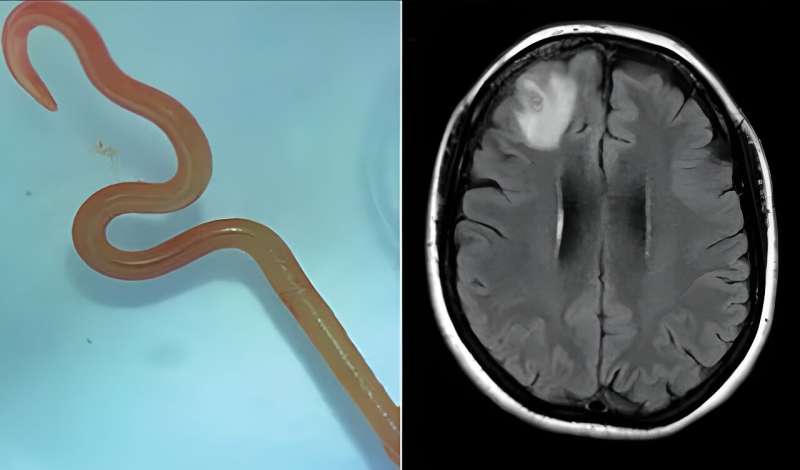Infection
Researchers say impact of preventable parasites, infectious diseases on Indigenous communities is a national shame
Many Australians likely read the coverage of the live roundworm found in the brain of a New South Wales woman with morbid curiosity. If you missed it, a wriggling, eight-centimeter-long parasitic roundworm was removed from the head of a 64-year-old woman complaining of headaches, depression and forgetfulness.
The patient likely picked up the parasite through eating foraged vegetables contaminated by python poo.
You may find it gross, but for researchers of parasites and infectious diseases—who recently met in Darwin for the Annual Meeting for the Australian Society for Parasitology—stories like this are fascinating but not particularly gross.
What we do find gross is the persistence of awful infectious diseases in situations where they are eminently preventable, and in countries that are rich enough to have eliminated them.
Particularly gross is the prevalence of infectious diseases in First Nations communities, despite those same infections being unknown or eradicated among non-Indigenous Australians.
In fact, as we heard at the conference, for some Indigenous and remote communities in Australia the problem of worms and other parasites is not only not improving—it’s potentially worsening.
A discredit to Australia
Indigenous Australians bear a disproportionate health burden for a swathe of infectious diseases that are otherwise only a problem in the world’s poorest countries.
It is an enduring discredit to our country that roundworm infections of humans are newsworthy and enthralling when reported in a Canberra hospital, but are widely ignored when they proliferate in Indigenous communities.
Like the snake parasite, many human-infecting worms belong to a group called soil-transmitted helminths, which means they are passed from animal to animal through contamination by contact with feces.
Several groups of soil-transmitted helminths are prevalent in Indigenous communities in both tropical and arid regions, although they have been virtually eliminated in Australian cities.
Last year, University of Melbourne parasite researchers measured the prevalence of human infection by one type of worm—the hookworm—at between 52% and 61% in Australian Indigenous communities. These same hookworms are largely eradicated in non-Indigenous communities and in most other wealthy countries.
More worrying was the finding that an even more serious and potentially deadly worm, the threadworm Strongyloides, infected 19 percent of people in remote Indigenous communities, with no clear improvement in these rates over the last 40 to 50 years.
The scabies mite is known only as a historic curiosity in most non-Indigenous communities, but as many as one third of children in remote Indigenous communities grow up with scabies infections, increasing their risk of chronic kidney or heart disease requiring dialysis or heart surgery.
In fact, these infectious diseases are so neglected that we don’t realistically know how many people in remote communities have them, or how much sickness and death they cause.
Giving a voice to health
The National Agreement on Closing the Gap was launched in 2008, and its first listed target was to reduce the life expectancy gap between Indigenous and non-Indigenous Australians within a generation, by 2031.
Despite improvements in some states, we are not on track to meet this target, and for women in the Northern Territory, the gap is actually worsening.
As Indigenous leader Noel Pearson noted at the recent Garma Festival, infectious diseases that disproportionately impact Indigenous Australians (including scabies, hookworms, trachoma, and Streptococcus bacteria that cause rheumatic heart disease) attract little comment in our national parliament, even by those parliamentarians who represent regions where these diseases are endemic.
Tragically, up to 90% of children in remote Indigenous communities have middle ear infections that threaten long term hearing problems.
More than a quarter of all Indigenous children have measured hearing loss, which can impact literacy and speech development. As well as losing their hearing, these children remain voiceless in our parliament and constitution.
Closing the gap
One potential benefit of an Indigenous Voice to Parliament might be the articulation of the story of the infectious disease burden that is too often unheard.
In New Zealand, government provision of health care and prevention of communicable disease now explicitly considers how they meet the obligations of the Treaty of Waitangi—an agreement now recognized as a constitutional relationship between Māori and the Crown.
As a result, although considerable gaps in health outcomes exist between Māori and non-Māori people, disparities have reduced, in an approach that Australia might learn from.
In Australia, Indigenous bodies like the National Aboriginal Community Controlled Health Organization (NACCHO) provide wise and informed advice to the Australian government, but the government can freely ignore this advice without comment.
Some of the major factors that contribute to high parasite prevalence in Indigenous communities can be tangibly and practically addressed: overcrowding, poor quality and insufficient maintenance of housing, and lack of functional infrastructure for laundry and washing.
But as with many other priority areas, the Closing the Gap 2031 targets for appropriate housing for Indigenous Australians are not on track to be met.
Ultimately, we need to listen deeply to Indigenous voices (constitutionally enshrined or otherwise) and let these urgent issues take the prominent place they deserve until they’re resolved—like a worm in our national consciousness.
University of Melbourne
Citation:
Researchers say impact of preventable parasites, infectious diseases on Indigenous communities is a national shame (2023, September 14)
retrieved 14 September 2023
from https://medicalxpress.com/news/2023-09-impact-parasites-infectious-diseases-indigenous.html
This document is subject to copyright. Apart from any fair dealing for the purpose of private study or research, no
part may be reproduced without the written permission. The content is provided for information purposes only.

